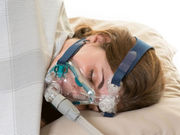At 9 months, apnea-hypopnea index is significantly lower with CPAP than with laparoscopic banding
THURSDAY, Nov. 9, 2017 (HealthDay News) — Continuous positive airway pressure (CPAP) may be a more effective treatment than laparoscopic gastric banding (LGB) for control of severe obstructive sleep apnea (OSA), according to a study published online Oct. 16 in the American Journal of Respiratory and Critical Care Medicine.
Jessie P. Bakker, Ph.D., from Brigham and Women’s Hospital in Boston, and colleagues randomized patients with a body mass index (BMI) of 35-45 kg/m2, severe OSA, and at least one OSA symptom to CPAP or laparoscopic gastric banding (LGB). In the LGB group, 14 of 28 underwent LGB only, 10 underwent CPAP only, and four underwent neither, while in the CPAP group, 20 of 21 received CPAP only and one began CPAP followed by gastric bypass surgery.
The researchers found that LGB was associated with a greater drop in BMI. In intention-to-treat analyses, the effective apnea-hypopnea index (AHI) at nine months was 29.5 and 20 events/hour in the LGB and CPAP groups, respectively (P = 0.02), while at 18 months, the effective AHI was 20.9 and 21.4 events/hour, respectively (P = 0.89). There were significant but similar improvements in Epworth Sleepiness Scale (ESS) scores with both treatments. Similar AHI and ESS results were seen in analyses limited to patients who received their assigned treatment. There was a linear relationship between change in AHI and change in BMI, with a 3.3 percent reduction in AHI for every 1 percent reduction in BMI. There was no difference in slope by treatment.
“The superior impact of CPAP on the effective AHI means that in our opinion, CPAP is a more effective treatment than LGB for control of OSA,” conclude the authors.
One author is now a paid employee for Philips Respironics, which also donated CPAP machines and supplies for the study. She accepted the position after study completion.
Copyright © 2017 HealthDay. All rights reserved.








